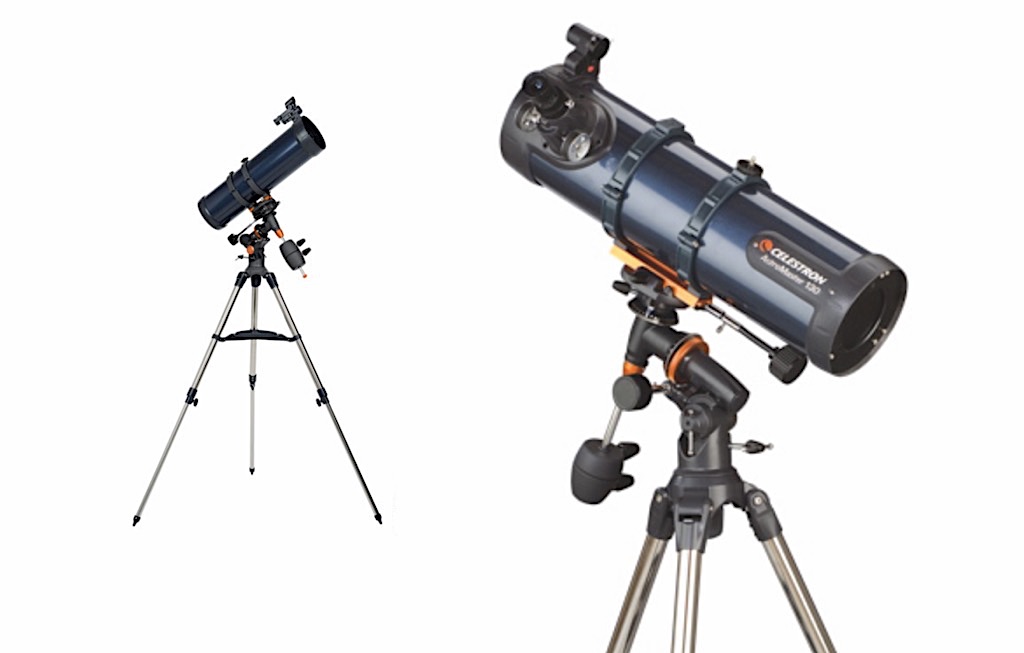
Telescopes are one of the most fun and interesting types of products you’ll find at Best Buy, and one of the most important considerations when buying a new telescope is the size of its aperture. Buyers must always be cognizant of the telescope’s aperture size, which is the diameter of its main light-gathering mirror or lens. This is because, generally speaking, the greater the aperture size, the sharper & brighter the observed image will be.
Of course, as aperture size increases, so does the price & weight of the telescope you’re considering. What you must decide is what you wish to view with the telescope you are purchasing, and adjust your price point and weight expectations accordingly. In the remainder of this article, I’ll consider 3 different aperture sizes (70-99mm, 100-129mm, and 130-149mm) and briefly discuss one telescope from each of these aperture classes.
70-99mm aperture size
In the 70-99mm size range, I’m looking at the Celestron Inspire 80AZ Refractor Telescope (shown at the top of the page). This light-bending telescope, with its 80mm aperture, not only features high-quality construction, but it also provides a number of useful features for beginning and amateur astronomers. For instance, it has an integrated smart phone adapter that’s both easy to operate and allows users to take amazing astronomical (and also terrestrial) images with their smart phone’s built in camera.
It also has a steel tripod that features an integrated (and fold-up) accessory tray, fully coated glass optics, a solid altazimuth mount featuring a unique asymmetrical design, and a whole lot more. With this telescope, you’ll be able to clearly see the Moon’s many craters and even identify features on Mars, such as that planet’s polar ice caps. In short, this telescope has everything you need to flourish in your new found field of interest!
100-129mm aperture size

The 100-129mm aperture range brings us the Explore Scientific ExploreOne Aurora II 114 x 1100mm Reflector Telescope—a model with a 114mm aperture that means increased light gathering capabilities for looking deeper into space at wonders like nebulae, star clusters, and even far away galaxies. This telescope also provides users with downloadable astronomy software that has a ton of useful information to make finding celestial objects a breeze. It also has a red dot viewfinder, an 1100mm focal length, and both 26mm and 9.7mm Plössl eyepieces, meaning you’ll have all the tools you need to explore the wonders of outer space without ever setting foot off planet.
130-149mm aperture size
Finally, there’s the 130-149mm range, where we find the Celestron 31045 AstroMaster 130EQ Telescope. With this ‘scope you not only get an amazing 130mm aperture size to work with, but you’ll also enjoy a 650mm focal length and up to 65x magnification. This means you’ll be doing some seriously high-magnification viewing of numerous deep space objects. In fact, you’ll see things like distant galaxies in much greater detail than with any of the sub 130mm telescopes out there.
Of course, the Celestron AstroMaster’s larger size does mean dealing with some additional weight. For instance, this telescope weighs 12.70 Kgs, which is just a shade under 30 pounds. So while it’s still technically portable, it may not be a whole lot of fun to drag around on a hilly astronomy hike or some similar viewing adventure.

Additional features offered with this model include a built-in StarPointer (for easily alining your ‘scope with interesting celestial objects), a sturdy tripod with steel tube legs, fully coated optics (for clear and detailed images), and a deluxe accessory tray—to name but a few. Like each of the telescopes in today’s overview, this model offers excellent features that make the hobby of astronomy one of the most fun, interesting, and educational pastimes a person can possibly take up.
Hopefully the information in today’s blog is helpful to you in your search for a new telescope. If you’d like to see more of Best Buy’s current selection of Telescopes, just click on the link and take a look. You can narrow the search to specific aperture diameter ranges by selecting the size you’re interested in from a list on the left hand side of the page. And remember, when it comes to buying a telescope, you can never have too much information, so do plenty of research beforehand and good luck to you!




My family and I are so excited about the Celestron Inspire 80AZ Refractor Telescope!!! Can’t wait until our little girl is big enough to appreciate what we can see with it
Comments are closed.